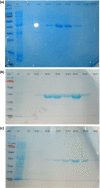Evaluation of two xenobiotic reductases from Pseudomonas putida for their suitability for magnetic nanoparticle-directed enzyme prodrug therapy as a novel approach to cancer treatment
- PMID: 32979040
- PMCID: PMC7568253
- DOI: 10.1002/mbo3.1110
Evaluation of two xenobiotic reductases from Pseudomonas putida for their suitability for magnetic nanoparticle-directed enzyme prodrug therapy as a novel approach to cancer treatment
Abstract
Directed enzyme prodrug therapy (DEPT) is a cancer chemotherapy strategy in which bacterial enzymes are delivered to a cancer site before prodrug administration, resulting in prodrug activation at the cancer site and more localized treatment. A major limitation to DEPT is the poor effectiveness of the most studied enzyme for the CB1954 prodrug, NfnB from Escherichia coli, at concentrations suitable for human use. Much research into finding alternative enzymes to NfnB has resulted in the identification of the Xenobiotic reductases, XenA and XenB, which have been shown in the literature to reduce environmentally polluting nitro-compounds. In this study, they were assessed for their potential use in cancer prodrug therapy strategies. Both proteins were cloned into the pET28a+ expression vector to give the genetically modified proteins XenA-his and XenB-his, of which only XenB-his was active when tested with CB1954. XenB-his was further modified to include a cysteine-tag to facilitate direct immobilization on to a gold surface for future magnetic nanoparticle DEPT (MNDEPT) treatments and was named XenB-cys. When tested using high-performance liquid chromatography (HPLC), XenB-his and XenB-cys both demonstrated a preference for reducing CB1954 at the 4-nitro position. Furthermore, XenB-his and XenB-cys successfully induced cell death in SK-OV-3 cells when combined with CB1954. This led to XenB-cys being identified as a promising candidate for use in future MNDEPT treatments.
© 2020 The Authors. MicrobiologyOpen published by John Wiley & Sons Ltd.
Conflict of interest statement
None declared.
Figures




Similar articles
-
Transformation of RDX and other energetic compounds by xenobiotic reductases XenA and XenB.Appl Microbiol Biotechnol. 2009 Sep;84(3):535-44. doi: 10.1007/s00253-009-2024-6. Epub 2009 May 20. Appl Microbiol Biotechnol. 2009. PMID: 19455327 Free PMC article.
-
Cloning and sequence analysis of two Pseudomonas flavoprotein xenobiotic reductases.J Bacteriol. 1999 Oct;181(20):6254-63. doi: 10.1128/JB.181.20.6254-6263.1999. J Bacteriol. 1999. PMID: 10515912 Free PMC article.
-
The dinitrobenzamide mustard prodrugs, PR-104A and SN27686, for use in a novel MNDEPT cancer prodrug therapy approach.Biosci Rep. 2023 Apr 26;43(4):BSR20230627. doi: 10.1042/BSR20230627. Biosci Rep. 2023. PMID: 37067816 Free PMC article.
-
Nitroreductase: a prodrug-activating enzyme for cancer gene therapy.Clin Exp Pharmacol Physiol. 2004 Nov;31(11):811-6. doi: 10.1111/j.1440-1681.2004.04085.x. Clin Exp Pharmacol Physiol. 2004. PMID: 15566399 Review.
-
The choice of prodrugs for gene directed enzyme prodrug therapy of cancer.Gene Ther. 1995 Dec;2(10):702-9. Gene Ther. 1995. PMID: 8750009 Review.
Cited by
-
Recent Strategies for the Immobilization of Therapeutic Enzymes.Polymers (Basel). 2022 Mar 30;14(7):1409. doi: 10.3390/polym14071409. Polymers (Basel). 2022. PMID: 35406282 Free PMC article. Review.
-
Structural Factors That Determine the Activity of the Xenobiotic Reductase B Enzyme from Pseudomonas putida on Nitroaromatic Compounds.Int J Mol Sci. 2022 Dec 26;24(1):400. doi: 10.3390/ijms24010400. Int J Mol Sci. 2022. PMID: 36613844 Free PMC article.
-
The YfkO Nitroreductase from Bacillus Licheniformis on Gold-Coated Superparamagnetic Nanoparticles: Towards a Novel Directed Enzyme Prodrug Therapy Approach.Pharmaceutics. 2021 Apr 9;13(4):517. doi: 10.3390/pharmaceutics13040517. Pharmaceutics. 2021. PMID: 33918536 Free PMC article.
References
-
- Anlezark, G. , Melton, R. , Sherwood, R. , Coles, B. , Friedlos, F. , & Knox, R. (1992). The bioactivation of 5‐(aziridin‐1-yl)‐2,4-dinitrobenzamide (CB1954)—I: Purification and properties of a nitroreductase enzyme from Escherichia coli ‐ A potential enzyme for antibody‐directed enzyme prodrug therapy (ADEPT). Biochemical Pharmacology, 44, 2289–2295. 10.1016/0006-2952(92)90671-5 - DOI - PubMed
-
- Ball, P. , Thompson, E. , Anderson, S. , Gwenin, V. , & Gwenin, C. (2019). Time dependent HPLC analysis of the product ratio of enzymatically reduced prodrug CB1954 by a modified and immobilised nitroreductase. European Journal of Pharmaceutical Sciences, 127, 217–224. 10.1016/j.ejps.2018.11.001 - DOI - PubMed
Publication types
MeSH terms
Substances
LinkOut - more resources
Full Text Sources

